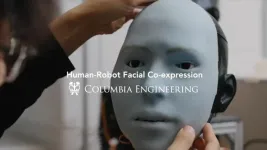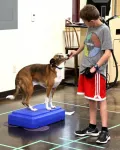(Press-News.org) What would you do if you walked up to a robot with a human-like head and it smiled at you first? You’d likely smile back and perhaps feel the two of you were genuinely interacting. But how does a robot know how to do this? Or a better question, how does it know to get you to smile back?
While we’re getting accustomed to robots that are adept at verbal communication, thanks in part to advancements in large language models like ChatGPT, their nonverbal communication skills, especially facial expressions, have lagged far behind. Designing a robot that can not only make a wide range of facial expressions but also know when to use them has been a daunting task.
Tackling the challenge
The Creative Machines Lab at Columbia Engineering has been working on this challenge for more than five years. In a new study published today in Science Robotics, the group unveils Emo, a robot that anticipates facial expressions and executes them simultaneously with a human. It has even learned to predict a forthcoming smile about 840 milliseconds before the person smiles, and to co-express the smile simultaneously with the person.
The team, led by Hod Lipson, a leading researcher in the fields of artificial intelligence (AI) and robotics, faced two challenges: how to mechanically design an expressively versatile robotic face which involves complex hardware and actuation mechanisms, and knowing which expression to generate so that they appear natural, timely, and genuine. The team proposed training a robot to anticipate future facial expressions in humans and execute them simultaneously with a person. The timing of these expressions was critical -- delayed facial mimicry looks disingenuous, but facial co-expression feels more genuine since it requires correctly inferring the human's emotional state for timely execution.
How Emo connects with you
Emo is a human-like head with a face that is equipped with 26 actuators that enable a broad range of nuanced facial expressions. The head is covered with a soft silicone skin with a magnetic attachment system, allowing for easy customization and quick maintenance. For more lifelike interactions, the researchers integrated high-resolution cameras within the pupil of each eye, enabling Emo to make eye contact, crucial for nonverbal communication.
The team developed two AI models: one that predicts human facial expressions by analyzing subtle changes in the target face and another that generates motor commands using the corresponding facial expressions.
To train the robot how to make facial expressions, the researchers put Emo in front of the camera and let it do random movements. After a few hours, the robot learned the relationship between their facial expressions and the motor commands -- much the way humans practice facial expressions by looking in the mirror. This is what the team calls “self modeling” – similar to our human ability to imagine what we look like when we make certain expressions.
Then the team ran videos of human facial expressions for Emo to observe them frame by frame. After training, which lasts a few hours, Emo could predict people’s facial expressions by observing tiny changes in their faces as they begin to form an intent to smile.
“I think predicting human facial expressions accurately is a revolution in HRI. Traditionally, robots have not been designed to consider humans' expressions during interactions. Now, the robot can integrate human facial expressions as feedback,” said the study’s lead author Yuhang Hu, who is a PhD student at Columbia Engineering in Lipson’s lab. “When a robot makes co-expressions with people in real-time, it not only improves the interaction quality but also helps in building trust between humans and robots. In the future, when interacting with a robot, it will observe and interpret your facial expressions, just like a real person.”
What’s next
The researchers are now working to integrate verbal communication, using a large language model like ChatGPT into Emo. As robots become more capable of behaving like humans, Lipson is well aware of the ethical considerations associated with this new technology.
“Although this capability heralds a plethora of positive applications, ranging from home assistants to educational aids, it is incumbent upon developers and users to exercise prudence and ethical considerations,” says Lipson, James and Sally Scapa Professor of Innovation in the Department of Mechanical Engineering at Columbia Engineering, co-director of the Makerspace at Columbia, and a member of the Data Science Institute. “But it’s also very exciting -- by advancing robots that can interpret and mimic human expressions accurately, we're moving closer to a future where robots can seamlessly integrate into our daily lives, offering companionship, assistance, and even empathy. Imagine a world where interacting with a robot feels as natural and comfortable as talking to a friend.”
END
Robot, can you say ‘cheese’?
Columbia engineers build Emo, a silicon-clad robotic face that makes eye contact and uses two AI models to anticipate and replicate a person’s smile before the person actually smiles.
2024-03-27
ELSE PRESS RELEASES FROM THIS DATE:
Filters, coupled with Digital Health Program, reduced arsenic levels by nearly half in study participants in households relying on well water in American Indian Communities
2024-03-27
A community-led water-testing project made up of households that rely on private well water with high arsenic levels saw on average a 47 percent drop in participants’ urinary arsenic levels after filters were installed and a digital health program was implemented, according to a new study led by researchers at the Johns Hopkins Bloomberg School of Public Health. Over the two-year study period, participating households received phone calls to encourage use of the filter and a reminder to replace the filter cartridge.
For the study—a ...
Oregon State dog-training program helps increase physical activity among kids with disabilities
2024-03-27
CORVALLIS, Ore. — By engaging regularly with their family dog and teaching it a series of tricks and commands, children with developmental disabilities experienced a significant increase in their daily physical activity, a new study from Oregon State University researchers found.
Children in the experimental group increased their moderate to vigorous physical activity by 17 minutes per day, while simultaneously reducing their sedentary time by nearly an hour per day.
“We often talk about physical activity as just fitness or exercise, but ...
Unlocking visible femtosecond fiber oscillators: A breakthrough in laser science
2024-03-27
The emergence of ultrafast laser pulse generation, marking a significant milestone in laser science, has triggered incredible progress across a wide array of disciplines, encompassing industrial applications, energy technologies, life sciences, and beyond. Among the various laser platforms that have been developed, fiber femtosecond oscillators, esteemed for their compact design, outstanding performance, and cost-effectiveness, have become one of the mainstream technologies for femtosecond pulse generation. However, their operating wavelengths ...
Long-period oscillations control the Sun’s differential rotation
2024-03-27
The Sun’s differential rotation pattern has puzzled scientists for decades: while the poles rotate with a period of approximately 34 days, mid-latitudes rotate faster and the equatorial region requires only approximately 24 days for a full rotation. In addition, in past years advances in helioseismology, i.e. probing the solar interior with the help of solar acoustic waves, have established that this rotational profile is nearly constant throughout the entire convection zone. This layer of the Sun stretches ...
A combination of approved drugs enhances the delivery of anti-bacterial medications to treat tuberculosis
2024-03-27
BOSTON – Tuberculosis (TB) is often overlooked in developed countries such as the United States, but this bacterial infection remains one of the deadliest diseases globally and results in millions of deaths annually.
Deaths can occur even with treatment, sometimes because of drug resistance in TB bacteria and other times due to poor delivery of TB-targeting drugs to patients’ infected lung tissue.
To address the latter challenge, a team led by researchers at Massachusetts General Hospital (MGH) in collaboration with scientists at the National Institute of Allergy and ...
Could AI play a role in locating damage to the brain after stroke?
2024-03-27
EMBARGOED FOR RELEASE UNTIL 4 P.M. ET, WEDNESDAY, MARCH 27, 2024
MINNEAPOLIS – Artificial intelligence (AI) may serve as a future tool for neurologists to help locate where in the brain a stroke occurred. In a new study, AI processed text from health histories and neurologic examinations to locate lesions in the brain. The study, which looked specifically at the large language model called generative pre-trained transformer 4 (GPT-4), is published in the March 27, 2024, online issue of Neurology® Clinical Practice, an official journal of the American Academy of Neurology.
A stroke can ...
High fat/low protein diets in rats during pregnancy and postnatally may cause altered glucose control and other "maladaptive" metabolic changes in their offspring
2024-03-27
High fat/low protein diets in rats during pregnancy and postnatally may cause altered glucose control and other "maladaptive" metabolic changes in their offspring
###
Article URL: https://journals.plos.org/plosone/article?id=10.1371/journal.pone.0299554
Article Title: Intrauterine and early-life malnutrition in rats disrupts the circadian rhythm programming of energy metabolites through adulthood
Author Countries: México
Funding: This research was partially supported by PD-LBAE-FC UNAM 2015-2019, DGAPA ...
Just 1 in 14 adults across 55 LMICs who have both hypertension and diabetes have both conditions under adequate control
2024-03-27
Just 1 in 14 adults across 55 LMICs who have both hypertension and diabetes have both conditions under adequate control, with only 20-30% of patients taking medications, indicating a lack of adequate healthcare in these settings.
======
Article URL: https://journals.plos.org/globalpublichealth/article?id=10.1371/journal.pgph.0003019
Article Title: Multiple cardiovascular risk factor care in 55 low- and middle-income countries: A cross-sectional analysis of nationally-representative, individual-level data from 280,783 adults
Author Countries: ...
Your emotional reaction to climate change may impact the policies you support
2024-03-27
Emotional reactions to climate change may lead to specific policy preferences, according to a study published March 27, 2024 in the open-access journal PLOS Climate by Teresa A. Myers of George Mason University and colleagues.
A politician, public speaker, or journalist may opt for an emotional appeal when communicating about climate change. Indeed, research shows that emotional investment can raise awareness of important issues and galvanize an otherwise apathetic public. However, existing research has not explored the unique links between specific ...
Persistent hiccups in a far-off galaxy draw astronomers to new black hole behavior
2024-03-27
At the heart of a far-off galaxy, a supermassive black hole appears to have had a case of the hiccups.
Astronomers from MIT, Italy, the Czech Republic, and elsewhere have found that a previously quiet black hole, which sits at the center of a galaxy about 800 million light years away, has suddenly erupted, giving off plumes of gas every 8.5 days before settling back to its normal, quiet state.
The periodic hiccups are a new behavior that has not been observed in black ...
LAST 30 PRESS RELEASES:
Numbers in our sights affect how we perceive space
SIMJ announces global collaborative book project in commemoration of its 75th anniversary
Air pollution exposure and birth weight
Obstructive sleep apnea risk and mental health conditions among older adults
How talking slows eye movements behind the wheel
The Ceramic Society of Japan’s Oxoate Ceramics Research Association launches new international book project
Heart-brain connection: international study reveals the role of the vagus nerve in keeping the heart young
Researchers identify Rb1 as a predictive biomarker for a new therapeutic strategy in some breast cancers
Survey reveals ethical gaps slowing AI adoption in pediatric surgery
Stimulant ADHD medications work differently than thought
AI overestimates how smart people are, according to HSE economists
HSE researchers create genome-wide map of quadruplexes
Scientists boost cell "powerhouses" to burn more calories
Automatic label checking: The missing step in making reliable medical AI
Low daily alcohol intake linked to 50% heightened mouth cancer risk in India
American Meteorological Society announces Rick Spinrad as 2026 President-Elect
Biomass-based carbon capture spotlighted in newly released global climate webinar recording
Illuminating invisible nano pollutants: advanced bioimaging tracks the full journey of emerging nanoscale contaminants in living systems
How does age affect recovery from spinal cord injury?
Novel AI tool offers prognosis for patients with head and neck cancer
Fathers’ microplastic exposure tied to their children’s metabolic problems
Research validates laboratory model for studying high-grade serous ovarian cancer
SIR 2026 delivers transformative breakthroughs in minimally invasive medicine to improve patient care
Stem Cell Reports most downloaded papers of 2025 highlight the breadth and impact of stem cell research
Oxford-led study estimates NHS spends around 3% of its primary and secondary care budget on the health impacts of heat and cold in England
A researcher’s long quest leads to a smart composite breakthrough
Urban wild bees act as “microbial sensors” of city health.
New study finds where you live affects recovery after a hip fracture
Forecasting the impact of fully automated vehicle adoption on US road traffic injuries
Alcohol-related hospitalizations from 2016 to 2022
[Press-News.org] Robot, can you say ‘cheese’?Columbia engineers build Emo, a silicon-clad robotic face that makes eye contact and uses two AI models to anticipate and replicate a person’s smile before the person actually smiles.




